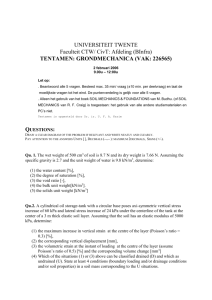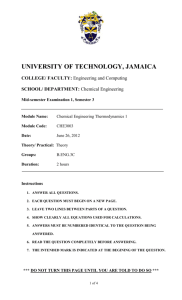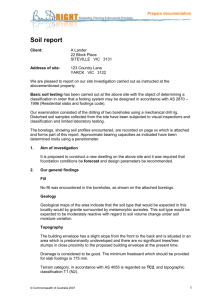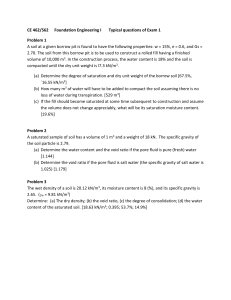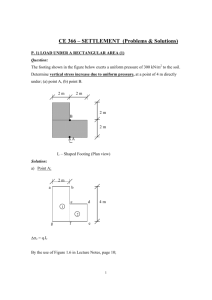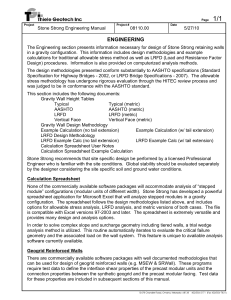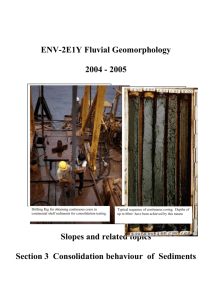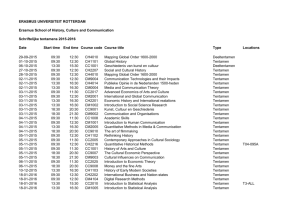UNIVERSITEIT TWENTE
advertisement
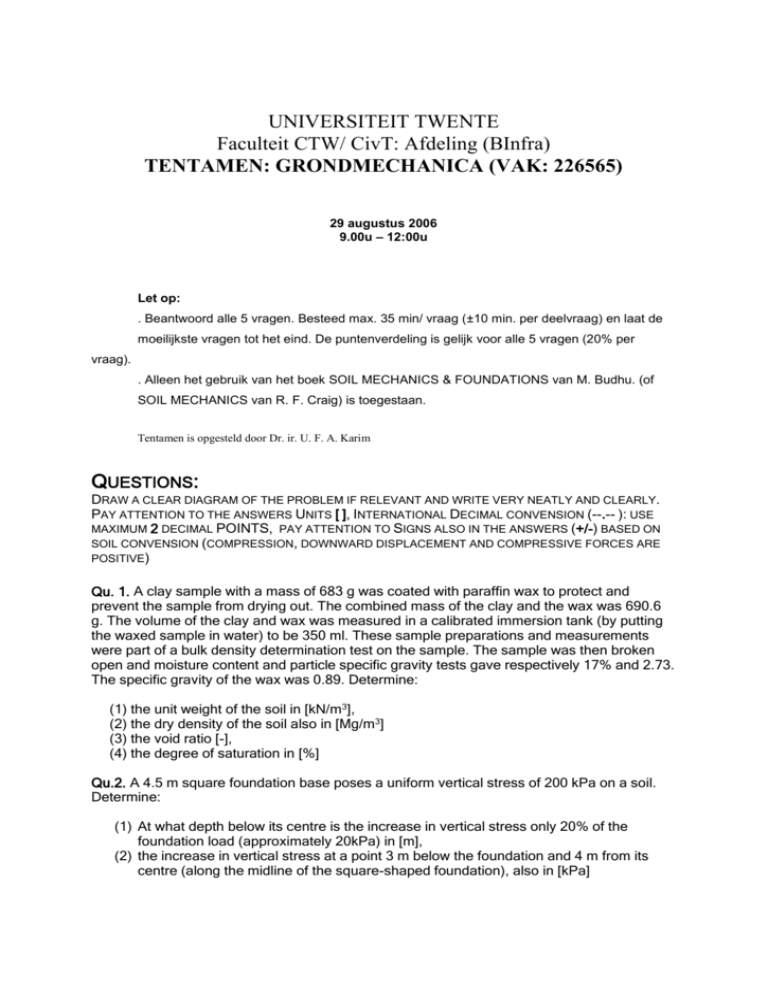
UNIVERSITEIT TWENTE Faculteit CTW/ CivT: Afdeling (BInfra) TENTAMEN: GRONDMECHANICA (VAK: 226565) 29 augustus 2006 9.00u – 12:00u Let op: . Beantwoord alle 5 vragen. Besteed max. 35 min/ vraag (±10 min. per deelvraag) en laat de moeilijkste vragen tot het eind. De puntenverdeling is gelijk voor alle 5 vragen (20% per vraag). . Alleen het gebruik van het boek SOIL MECHANICS & FOUNDATIONS van M. Budhu. (of SOIL MECHANICS van R. F. Craig) is toegestaan. Tentamen is opgesteld door Dr. ir. U. F. A. Karim QUESTIONS: DRAW A CLEAR DIAGRAM OF THE PROBLEM IF RELEVANT AND WRITE VERY NEATLY AND CLEARLY. PAY ATTENTION TO THE ANSWERS UNITS [ ], INTERNATIONAL DECIMAL CONVENSION (--.-- ): USE MAXIMUM 2 DECIMAL POINTS, PAY ATTENTION TO SIGNS ALSO IN THE ANSWERS (+/-) BASED ON SOIL CONVENSION (COMPRESSION, DOWNWARD DISPLACEMENT AND COMPRESSIVE FORCES ARE POSITIVE) Qu. 1. A clay sample with a mass of 683 g was coated with paraffin wax to protect and prevent the sample from drying out. The combined mass of the clay and the wax was 690.6 g. The volume of the clay and wax was measured in a calibrated immersion tank (by putting the waxed sample in water) to be 350 ml. These sample preparations and measurements were part of a bulk density determination test on the sample. The sample was then broken open and moisture content and particle specific gravity tests gave respectively 17% and 2.73. The specific gravity of the wax was 0.89. Determine: (1) the unit weight of the soil in [kN/m3], (2) the dry density of the soil also in [Mg/m3] (3) the void ratio [-], (4) the degree of saturation in [%] Qu.2. A 4.5 m square foundation base poses a uniform vertical stress of 200 kPa on a soil. Determine: (1) At what depth below its centre is the increase in vertical stress only 20% of the foundation load (approximately 20kPa) in [m], (2) the increase in vertical stress at a point 3 m below the foundation and 4 m from its centre (along the midline of the square-shaped foundation), also in [kPa] Qu. 3. In a 2-layered construction ground, the following is known from a laboratory and a field investigation: Top soil layer I: Sand, 5 m thick, water table is at ground level, unit weight 18 kN/m3. Bottom soil layer II: Clay, thickness: deep, unit weight 20 kN/m3. Assuming full saturation and unit weight of water of 9.81 kN/m3, determine: (1) the effective stresses at depths of z= 5 m (layer I) and z= 10 m (within layer II) below ground level in [kPa], (2) the over consolidation ratios [-] at these depths assuming a maximum past geological stress on the current ground level of 100 kPa. (3) The effective stress change [in kPa] (above or below!) the existing effective vertical stress at 5 m depth after a long time due to a slow drop over time in the water table by 2.5 m due to long-term continuous pumping to keep the water level at that depth. Assume no change in the unit weight of the sand layer above and below the water table and that no capillary action is observed. The over consolidation ratio is 1. (4) The effective stress change shortly after loading at 10 m depth resulting from a sudden rise in the water table by 2.5 m [in kPa] due to failure of a nearby earth dam. The over consolidation ratio is 1. Qu. 4. A soft normally consolidated clay layer 15 m thick with water table at ground level has the following characteristics: saturated unit weight 17.2 kN/m3, over consolidation ratio 1, moisture content 45%, particle specific gravity 2.68, compression and rebound parameters respectively Cc = 0.495 and Cr = 0.05. This layer is overlain by a foundation directly placed on the ground imposing a vertical effective stress increase at the centre of the layer of 10 kPa. Calculate the approximate value of the settlement of the foundation in [mm]. Qu. 5. Consolidated Undrained (CU) shear box tests on a series of soil samples lead to the following results: Test no. 1 2 3 4 total normal consolidation stress [kPa] 100 200 300 400 total shear stress at failure [kPa] 98 139 180 222 From these data estimate (i) the cohesion in [kPa]; (ii) the shear angle of friction at failure in degrees [o] (iii) Show the Mohr circle for test 2 only. Can this circle shrink and fall below the failure line? (iv) what is the value of the shear angle measured if the 4 tests are carried on unconsolidated undrained samples (UU test) in degrees [o] 2

